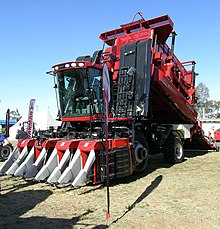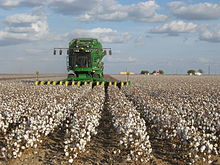Cotton harvesters
As a cotton picker, cotton picker or cotton harvester or Baumwollpflückmaschine is an agricultural implement or vehicle for the mechanized harvesting of cotton referred to. Until these machines became popular after the Second World War , the cotton was harvested by hand. Manual harvesting by human cotton pickers is still widespread in some emerging and developing countries.
history
The first patent for a machine for harvesting of cotton was already notified to 1850. But it took another hundred years for cotton harvesters to become established in agriculture . During this time, various inventors experimented with pneumatic or electric cotton picking systems, but without any notable success. In the pneumatic systems, attempts were made to suck or blow the fibers out of the capsule, while the electrical systems were supposed to pull the fibers out of the capsule mechanically with statically charged straps or fingers. Other machines would harvest the whole plant and then separate the fiber from the rest of the plant material, much like a combine harvester .
Other machines, on the other hand, combed the plants with tines and picked up the capsules. This process is still used today for cotton strippers , even if it has been greatly improved technically . The most promising, however, proved to be the use of spindles, fingers or claws, which picked up the cotton from the opened capsules without damaging the leaves or unopened capsules. Agnus Campbell, an agricultural engineer from Chicago , Illinois , recognized as early as the 1880s that such machines with spindles are best suited for harvesting cotton. Together with Theodore H. Price, he founded the Price-Campbell Cotton Picker Corporation in 1912. However, the harvesting results of their machines remained unsatisfactory. While the toothed feed spindles kept clogging, the Texan John Rust had the idea in the 1930s to use smooth spindles and to keep them moist, so that the first acceptable results could be achieved.
Now larger agricultural machinery manufacturers are also interested in cotton picking machines. International Harvester acquired Price-Campbell's patents and worked on the development of a spindle picker after it was recognized that it was superior to the pneumatic system. In 1942 the company announced that it was ready to mass-produce a cotton harvester. However, due to a lack of steel as a result of the war economy, production could not start until 1949.
Even with Deere & Company had been working on the development of a Baumwollpflückmaschine, but this project rehired 1,931th The company acquired the patents of Hiram M. Berry of Greenville, Mississippi , who had worked with corkscrew-shaped spindles as early as the 1920s, and achieved some success with it. In 1950 the production of a two-row cotton harvester began, which was more efficient than the previous single-row machines.
Around this time, the Allis-Chalmers company also started producing cotton harvesters by acquiring the right to use John Rust's patents. Rust's patents were also used on machines made by Ben Pearson in Arkansas .
Today's cotton harvest

Most common today are cotton picking machines with spindles. These machines work with a large number of moist, toothed spindles that run on a rotating shaft and turn around themselves again. The spindles wind up the cotton from the capsules and transfer it to counter-rotating comb rollers. In other cotton harvesting machines, the spindles are arranged eccentrically on the shaft so that the cotton is stripped off inside the machine. The cotton is then usually transported with air pressure into the basket, where it is compressed and pre-compressed.
However, cotton strippers are still used today, especially for ducking the low-growing storm-resistant cotton in Texas ( storm proof cotton ). These machines take part of the plant like unopened capsules, the unopened capsules are then broken open and the heavy plant material separated from the cotton fiber so that only the fiber material gets into the basket.
Modern cotton picking machines have harvest units for up to eight rows of cotton. Most modern cotton harvesters are self-propelled , which means they have their own engine and transmission, while older models were mostly pulled by tractors or mounted on tractors.
When the basket of a cotton harvester is full, the contents are emptied into a so-called module builder , a compacting machine. Here the cotton is hydraulically compressed into large bales ( modules ) that can either be stored in the field or at a collection point. Such a module weighs around ten tons. The bales are then trucked to the egrenizing machine , where the seeds are combed out of the cotton. Recently there are also cotton pickers with an integrated Module Builder.
Since the cotton often ripens irregularly, the fields are usually harvested several times in a row. Often the cotton is also chemically defoliated in order to facilitate harvesting with the cotton picker, especially when harvesting with cotton strippers and there is no frost.
The largest manufacturers of cotton harvesters include John Deere and Case, the successor to IHC .
Web links
- DIN NAM - ISO / TC 23 / SC 7 / WG 3 Safety requirements for combine harvesters, forage harvesters and cotton harvesters
- John Deere Cotton Picker Product Page
- CASE product page cotton harvesting machines
- Operating instructions for a John Deere cotton picker
- Video of a cotton picker with internal Module Builder
Individual evidence
- ↑ Archive link ( Memento of the original from March 31, 2008 in the Internet Archive ) Info: The archive link was inserted automatically and has not yet been checked. Please check the original and archive link according to the instructions and then remove this notice.
- ↑ Archive link ( Memento of the original from March 31, 2008 in the Internet Archive ) Info: The archive link was inserted automatically and has not yet been checked. Please check the original and archive link according to the instructions and then remove this notice.


